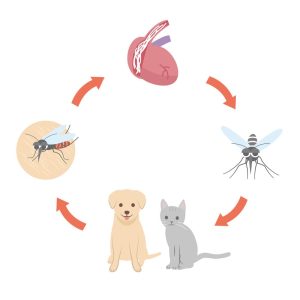One prevalent threat that pet owners must be aware of is heartworm disease. This insidious and potentially fatal condition affects dogs, cats, and occasionally other animals.
In this blog post, we will delve into the mechanisms behind how pets contract heartworm and explore preventive measures that can protect our beloved furry companions.
Understanding Heartworm Disease
Heartworm disease is caused by the parasitic roundworm known as Dirofilaria immitis. The disease primarily affects dogs, but cats, ferrets, and other mammals can also become infected. It is prevalent in many regions worldwide, with the highest incidences occurring in areas with warm climates and mosquito populations.
How Does the Infection Occur?
The life cycle of heartworms involves several stages, with mosquitoes acting as intermediate hosts. Here is a step-by-step explanation of how pets contract heartworm:
- Infected Host: Adult heartworms reside in the pulmonary arteries and heart chambers of infected animals, typically dogs or other wild canids. These animals are considered the primary reservoir of heartworm disease.
- Microfilariae Production: Female heartworms release microscopic larvae called microfilariae into the bloodstream of the infected host. These microfilariae can only survive in the bloodstream for a limited time, usually a couple of years.
- Mosquito Transmission: When a mosquito bites an infected host, it ingests the microfilariae along with the blood. Within the mosquito, the microfilariae develop further over a two-week period into the infective stage larvae.
- Infecting a New Host: The mosquito, now carrying the infective larvae, seeks another warm-blooded animal to bite and transmit the heartworm disease. When a mosquito infected with these larvae bites a susceptible pet, the larvae are injected into the pet’s bloodstream.
- Maturing into Adult Heartworms: The infective larvae migrate through the pet’s tissues, eventually reaching the heart and nearby blood vessels. Over the course of several months, the larvae mature into adult heartworms, reaching sizes of up to 12 inches in length. The adult worms can live for several years in the pet’s heart, leading to further complications.
Preventing Heartworm Infection
Fortunately, heartworm disease is preventable through the diligent use of preventive medications. Here are some key prevention strategies for safeguarding your pets:
- Regular Veterinary Check-ups: Schedule annual wellness exams for your pets, during which your veterinarian can conduct heartworm tests and prescribe preventive medications.
- Administer Preventive Medications: Administer heartworm preventive medications to your pets as directed by your veterinarian. These medications typically come in the form of chewable tablets, topical treatments, or injections. They work by killing the immature larvae and preventing the development of adult heartworms.
- Mosquito Control: Reduce your pet’s exposure to mosquitoes by eliminating standing water around your home, using mosquito repellents designed for pets, and keeping your pets indoors during peak mosquito activity times, such as dawn and dusk.
- Year-round Protection: Heartworm disease is a year-round threat in many regions, so it is crucial to provide continuous protection by administering preventive medications throughout the year, even during the colder months.
Consults Your Vet
Heartworm disease poses a significant risk to our beloved pets, but with proper understanding and preventive measures, we can effectively protect them.
Remember to consult your veterinarian for guidance on the most appropriate heartworm prevention strategies for your specific pet. By taking proactive steps to prevent heartworm infection, we can ensure that our furry friends live long, healthy, and happy lives by our side.

